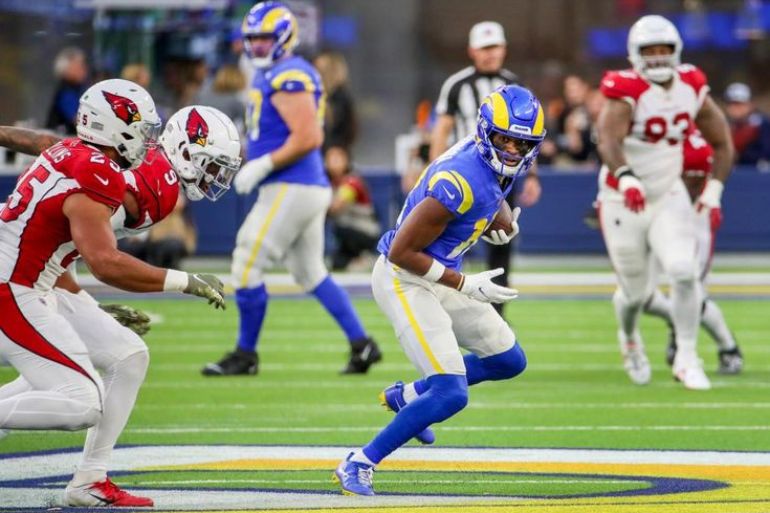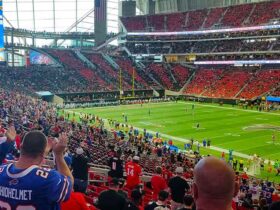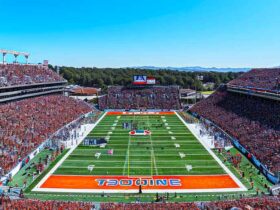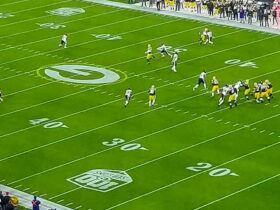The NFL Teams List catalogs 32 professional football franchises in the National Football League. The league splits these teams into two conferences: the American Football Conference (AFC) and the National Football Conference (NFC), with 16 teams each. Each conference has four geographic divisions—East, North, South, and West—and every division contains four teams.
Teams play 17 games in an 18-week regular NFL season. The playoff system lets seven teams from each conference move forward. These include four division winners and three wild card teams that compete to reach the NFL championship game, the Super Bowl.
NFL teams play in 30 active stadiums across the United States. Two stadiums serve multiple teams: SoFi Stadium in Los Angeles houses both the Rams and Chargers, while MetLife Stadium near New York City is home to the Giants and Jets.
Teams spread throughout the country, and some states host multiple franchises. California, Florida, and New York lead with three NFL teams each. The New York Giants and Jets represent New York City but play their home games in New Jersey. This makes the Buffalo Bills the only team that plays within New York State’s borders.
The league grants each NFL team a franchise to operate in its home city. These franchises come with specific territorial rights:
- Home Territory – A 75-mile radius around city limits (or half the distance between two nearby league cities if they’re within 100 miles of each other)
- Home Marketing Area – The Home Territory plus the rest of the state where the club operates, and the area where the team holds its training camp during that period
These territories give NFL members exclusive rights to host professional football games in their Home Territory. Teams can also advertise, promote, and host events in their Home Marketing Area.
The Dallas Cowboys stand out as the world’s most valuable sports franchise, worth $12.80 billion in 2025. NFL teams average $7.13 billion in value, and all franchises combined reach $228.00 billion.
Teams can have up to 55 players during regular season, though only 48 can play on game days. They also maintain a separate 16-player practice squad.
The NFL Teams List started with just 14 member teams in 1920 and grew to today’s 32 franchises. This growth shows how professional football has developed in the United States in the last century.
How are NFL teams organized?
The NFL splits its 32 teams into a well-laid-out system that aids scheduling, travel planning, rivalry building, and playoff spots. The league’s teams are split between two conferences: the American Football Conference (AFC) and the National Football Conference (NFC). This setup came about in 1970 when the NFL merged with the American Football League.
Both conferences have 16 teams split into four geographic divisions—East, North, South, and West—with four teams each. Teams in the same division play each other twice every season, which makes up six games of their yearly schedule. This setup helps cut down travel time since teams often play against others in their region.
The divisions have stayed the same since 2002 when the Houston Texans became the 32nd team. Before the Texans joined, the NFL ran with three divisions per conference for over 30 years, starting from the 1970 merger. The league needed to reshape into four divisions per conference after adding the Texans.
NFL rules let each team keep 55 players during regular season, though only 48 can play on game days. Teams can also have a separate 16-player practice squad.
The NFL calls itself a trade group made up and funded by its 32 member teams. The league gave up its tax-exempt status as a nonprofit 501(c)(6) association in 2015.
Three main officers run the league: the commissioner, secretary, and treasurer. Each conference also has a president – mostly a ceremonial role with few powers, like giving out the conference championship trophy. Two-thirds of league members (at least 18) must vote to elect a commissioner, while conference presidents need approval from three-fourths (minimum 10) of their conference members.
The NFL gives each club a franchise to run their team in their home city. This franchise comes with specific territory rights:
- Home Territory: A 75-mile radius around city limits (or halfway between two nearby league cities if they’re within 100 miles)
- Home Marketing Area: The Home Territory plus the rest of the team’s state and training camp location during camp
These territories give teams exclusive rights to host pro football games in their Home Territory and run promotions throughout their Marketing Area. Teams that share cities (like New York and Los Angeles) or states (California, Florida, and Texas) split these rights.
This structure helps keep teams competitive, builds strong regional rivalries, creates clear paths to playoffs, and keeps the league running smoothly for years to come.
List of NFL teams by conference and division
The NFL consists of 32 teams split equally between two conferences and eight divisions. This setup naturally creates rivalries and balanced competition throughout the league. Here’s a complete breakdown of NFL teams by their conference and division.
AFC East
Four teams make up the AFC East, mostly in the northeastern United States. The Buffalo Bills make Highmark Stadium their home in Orchard Park, New York. Hard Rock Stadium serves as the base for the Miami Dolphins in Miami Gardens, Florida. The New England Patriots represent Foxborough, Massachusetts at Gillette Stadium. The New York Jets share MetLife Stadium with their NFC rivals in East Rutherford, New Jersey.
AFC North
M&T Bank Stadium in Baltimore, Maryland serves as home base for the Baltimore Ravens. The Cincinnati Bengals defend Paycor Stadium in Cincinnati, Ohio. The Cleveland Browns represent Huntington Bank Field in Cleveland, Ohio. The Pittsburgh Steelers round out this division at Acrisure Stadium in Pittsburgh, Pennsylvania.
AFC South
NRG Stadium in Houston, Texas houses the Houston Texans. The Indianapolis Colts defend Lucas Oil Stadium in Indianapolis, Indiana. EverBank Stadium serves as the battleground for the Jacksonville Jaguars in Jacksonville, Florida. The Tennessee Titans complete this division at Nissan Stadium in Nashville, Tennessee.
AFC West
The Denver Broncos defend Empower Field at Mile High in Denver, Colorado. GEHA Field at Arrowhead Stadium hosts the Kansas City Chiefs in Kansas City, Missouri. The Las Vegas Raiders defend Allegiant Stadium in Paradise, Nevada. The Los Angeles Chargers share SoFi Stadium in Inglewood, California with the Rams.
NFC East
AT&T Stadium in Arlington, Texas serves as home turf for the Dallas Cowboys. The New York Giants share MetLife Stadium with the Jets in East Rutherford, New Jersey. Lincoln Financial Field hosts the Philadelphia Eagles in Philadelphia, Pennsylvania. The Washington Commanders represent Northwest Stadium in Landover, Maryland.
NFC North
The Chicago Bears defend historic Soldier Field in Chicago, Illinois. Ford Field in Detroit, Michigan houses the Detroit Lions. The legendary Lambeau Field serves as home to the Green Bay Packers in Green Bay, Wisconsin. U.S. Bank Stadium hosts the Minnesota Vikings in Minneapolis, Minnesota.
NFC South
The Atlanta Falcons defend Mercedes-Benz Stadium in Atlanta, Georgia. Bank of America Stadium serves as home base for the Carolina Panthers in Charlotte, North Carolina. The New Orleans Saints represent the Caesars Superdome in New Orleans, Louisiana. Raymond James Stadium hosts the Tampa Bay Buccaneers in Tampa, Florida.
NFC West
State Farm Stadium in Glendale, Arizona houses the Arizona Cardinals. The Los Angeles Rams share SoFi Stadium with the Chargers in Inglewood, California. The San Francisco 49ers defend Levi’s Stadium in Santa Clara, California. Lumen Field serves as home to the Seattle Seahawks in Seattle, Washington.
The NFL’s current structure dates back to 2002 when the Houston Texans became the 32nd team. Teams face their division rivals twice each season. This creates strong regional rivalries and keeps travel distances reasonable for teams in the same area.
Key facts about each NFL team
NFL teams each have their own unique story and operational style that sets them apart in the league. Their history, from founding dates to current stadium sizes, helps us understand today’s NFL landscape better.
Team name and location
The United States has NFL franchises spread across 22 states and 30 cities. California and Florida lead the pack with three teams each, which makes sense given their large populations and size. Some teams play in surprising locations. The New York Giants and Jets actually play their home games in East Rutherford, New Jersey. Teams like the New England Patriots (based in Foxborough, Massachusetts) and Carolina Panthers (Charlotte, North Carolina) represent broader regions. Los Angeles (Rams and Chargers) and New York/New Jersey (Giants and Jets) are home to multiple NFL teams.
Stadium and capacity
The league’s 32 teams play in 30 different stadiums, as two facilities host multiple teams. MetLife Stadium serves both the Giants and Jets with the highest listed seating capacity at 82,500. AT&T Stadium, home to the Cowboys, can pack in over 100,000 fans when you count standing room. The Bears’ Soldier Field sits at the other end with room for 61,500 fans.
Most NFL venues (17) hold fewer than 70,000 people. Eight stadiums fit between 70,000-80,000 fans, and five can welcome 80,000 or more. Stadium names tell their own story – Arrowhead Stadium, Lambeau Field, and Soldier Field remain the only venues without corporate sponsorship. SoFi Stadium in Inglewood (Rams/Chargers) and Allegiant Stadium in Paradise, Nevada (Raiders) are the newest additions, both opening their doors in 2020.
Year founded
The Arizona Cardinals claim the title of oldest NFL franchise, dating back to 1898 as an independent team before joining the league at its birth in 1920. The Chicago Bears, first known as the Decatur Staleys, also started playing in that inaugural 1920 season. The Green Bay Packers, founded in 1921, stand out as the oldest team still playing in its original city.
The 1970 AFL-NFL merger brought eight former AFL teams into the fold. The Houston Texans, who started playing in 2002, are the newest addition to the NFL family. Teams like the Raiders (Oakland-Los Angeles-Oakland-Las Vegas) and Rams (Cleveland-Los Angeles-St. Louis-Los Angeles) have moved multiple times throughout their history.
Current head coach
Pittsburgh Steelers’ Mike Tomlin leads the pack as the longest-serving active head coach, running the show since 2007. Andy Reid of the Kansas City Chiefs stands alone among active coaches with three Super Bowl victories. Tomlin, John Harbaugh, Sean McVay, Sean Payton, Pete Carroll, and Nick Sirianni have also earned Super Bowl rings as head coaches.
NFL head coaches range from 37-year-old Kellen Moore (New Orleans Saints) to 73-year-old Pete Carroll (Las Vegas Raiders). Sean McVay made NFL history twice – as the youngest head coach hired in the modern era at 30 and the youngest Super Bowl winner at 36.
Fun facts about NFL teams
NFL statistics and unique characteristics paint a fascinating picture of professional football teams. These distinctive elements tell compelling stories about the league’s rich history and competitive nature.
The Dallas Cowboys lead all sports franchises globally with their estimated worth of USD 12.80 billion as of 2025. NFL teams average approximately USD 7.13 billion in value, and their collective worth reaches USD 228.00 billion.
The Green Bay Packers stand out with their unique structure as a publicly owned, non-profit corporation – the only team in the NFL with this arrangement. Their community-focused ownership model has helped them achieve an impressive 790 total wins throughout their history.
NFL teams have spread across 23 different states. Florida and California each host three teams, which creates intense regional rivalries within their borders.
Team names reveal interesting patterns in the NFL. Birds dominate the naming theme for five franchises: the Atlanta Falcons, Philadelphia Eagles, Seattle Seahawks, Baltimore Ravens, and Arizona Cardinals.
Record books tell stories of triumph and failure. The Indianapolis Colts set an NFL record with 23 consecutive wins between 2008-2009. The Tampa Bay Buccaneers struggled through the league’s longest losing streak with 26 straight losses from 1976-1977.
The 1972 Miami Dolphins achieved something special – they remain the only team to complete a perfect season, winning every regular season and playoff game. No other team has matched this feat in five decades.
The NFL’s history includes some notable gaps. All but one of these teams – the Cleveland Browns, Detroit Lions, Houston Texans, and Jacksonville Jaguars – have never reached the Super Bowl. The Buffalo Bills made history differently by reaching four straight Super Bowls (1991-1994) without winning any, showing remarkable consistency but ultimate disappointment.
Most successful and popular NFL teams
NFL success comes in many forms – from championship wins to financial gains and fan following. The Green Bay Packers lead the pack with 13 championship titles, making them the most successful franchise in NFL history. The Chicago Bears have nine championships to their name, while the New York Giants follow with eight.
The Kansas City Chiefs have become a powerhouse in the last decade, with a 75.0% winning record. Their stellar performance shows in multiple Super Bowl appearances, and Andy Reid remains the only active coach who has won multiple Super Bowls.
The Dallas Cowboys’ financial dominance extends beyond the NFL into all professional sports, with a $13.00 billion valuation in 2025. This value jumped 29% from 2024. The Los Angeles Rams at $10.50 billion and New York Giants at $10.10 billion hold second and third place respectively.
Team valuations across the league now average $7.10 billion, showing a 25% growth from last year. Every NFL franchise has crossed the $5.00 billion mark – a first in league history.
The Cowboys’ popularity shines through their social media presence with 19.7 million followers across major platforms. The New England Patriots with 17.3 million followers and Pittsburgh Steelers with 15.4 million followers complete the top three most-followed teams.
The Baltimore Ravens boast the highest regular season win-loss percentage at .574. The Packers hold the record for most wins with 811 in NFL history. The Patriots’ playoff dominance shows in their .627 postseason win percentage, highlighting their championship success.
Also Read – Latest news











Leave a Reply